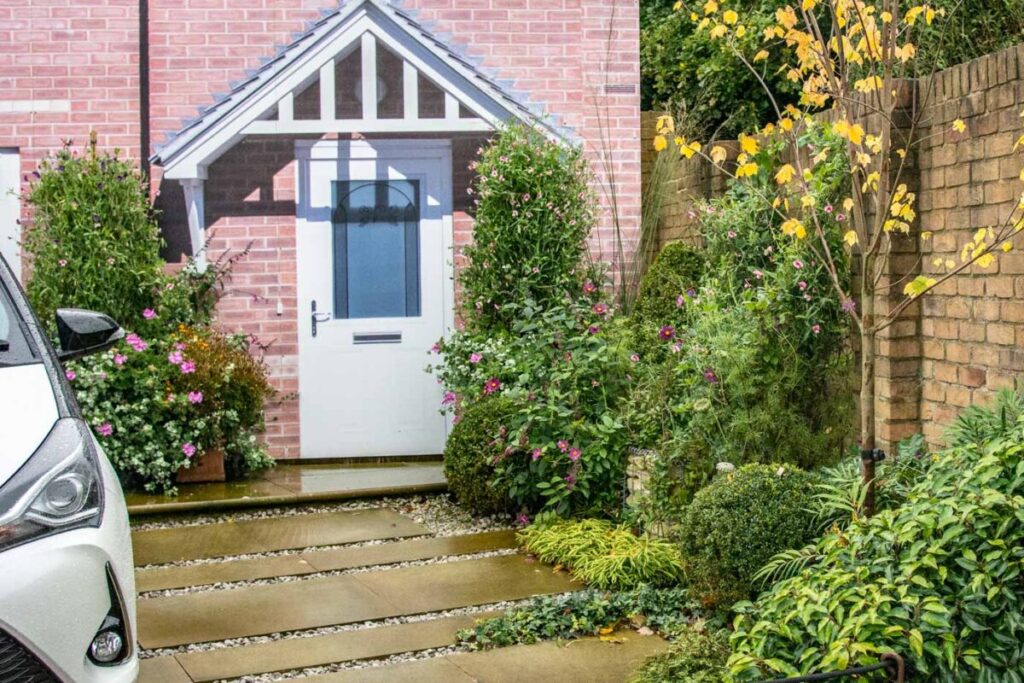
Up Front Garden Design
I thought I’d make a change from normal proceedings this time around, and rather than focus on a garden design principle or tip I thought I’d consider a specific area of our home: often overlooked, but always on view, our front gardens frequently get short shrift when it comes to imaginative home improvement.
Recent trends in front gardens have seen significant increases in full paving practices and substantial reductions in plants both of which have detrimental knock on effects to humans, wildlife and the planet as a whole. It may sound dramatic and it’s easy to think that ‘my little bit’ won’t make a difference but cumulatively lots of ‘little bits’ following these trends are increasing the possibilities of flooding, contributing to climbing urban temperatures and pollution levels, impacting negatively on wildlife and making our environment more fractious, depressing places to live.
It may sound trite to say that a little bit of garden design inspiration can help mitigate these very real threats to ours and our natural world’s existence but if we all start to really think about the space outside our homes as a ‘garden’ first and a car park or a bin store or a mere transition point from a pavement to our front door second, then we just might stand a chance of reversing these damaging trends. Don’t get me wrong, I still stand by the design mantra of ‘form ever follows function’ but there’s no ‘form’ in fully paving a front garden; it is functionality without form and it is that idea – that you have to sacrifice form entirely in order to get a car (as an example) onto your front garden – that I want us all to reconsider. With a little bit of imagination and an application of design principles there is no reason why we can’t have our cake and eat it too i.e. have a functional but still lovely front garden.
So, some top tips for achieving it? Read on…
- Approach your front garden design as you would your back garden. Be considered!
- Make a plan of your front garden so you know how much space you have available to you. Make particular note of boundaries and house walls too.
- Don’t fall into the trap of thinking that the only option available to you is to completely pave over your garden!
- Minimise paving as much as you can, either don’t include any at all or combine paving with permeable surfaces so that rainwater can penetrate to the ground below. This will help mitigate the potential for flooding.
- Make a list of what you want to use your front garden for. If its car parking for instance, consider how many cars you really need to park on your front garden (if space allows!). If the number includes ‘occasional’ or overspill spaces you can be more creative with that. For instance you can occasionally park on a lawn (especially if it’s been reinforced with plastic cell/mesh products!). And night time and weekend only cars can be accommodated with gravel options and drive over planting such as Thyme, Creeping Jenny (use this one sparingly, it can be invasive!) or Ajuga.
- Aim to maximise planting – it reduces pollution, urban heating, can help reduce flooding, is great for wildlife and humans alike:
- Consider hedges instead of boundary walls or fences – hedges are great for screening, for wildlife and also act as a filter for dust from the street – they also look great!
- If you can’t use a hedge look at your boundaries and house walls for vertical and climbing plant potential.
- Use corners for planting opportunities – you usually can’t park in a corner! Consider small trees in corners that can add height and interest to your space.
- If you have very little space available to you utilise containers to their best effect – you can still get plants around you!
- Also consider green roofing – can you plant up your car port or bin store roof?
Hopefully this will give you some ideas of where to start and we can all begin to make our neighbourhoods lovelier places to be! Check out the RHS website too for more ideas about how to green your little bit of grey Britain.




